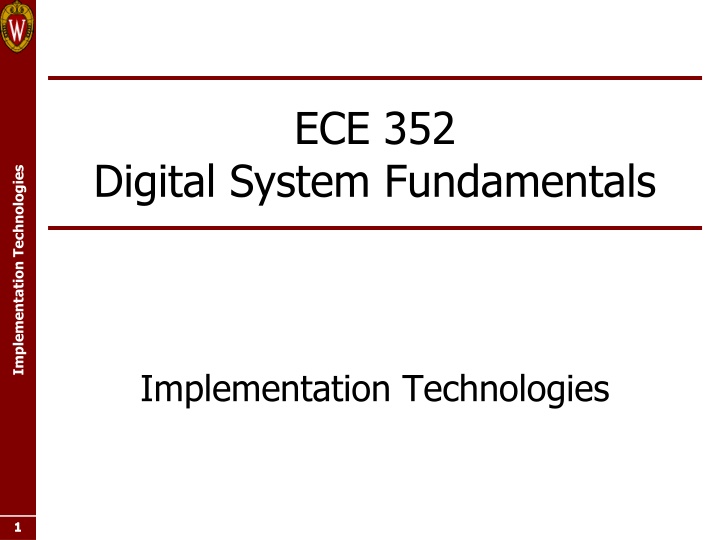
Digital System Fundamentals: Implementation Technologies Overview
Delve into the world of digital system implementation technologies, covering custom hardware, programmable logic devices, and FPGAs. Understand manual layout processes, standard cells, and the tradeoffs between custom and programmable hardware. Explore the logic configuration and routing in FPGAs, featuring LUTs and memory bits for efficient circuit design.
Download Presentation

Please find below an Image/Link to download the presentation.
The content on the website is provided AS IS for your information and personal use only. It may not be sold, licensed, or shared on other websites without obtaining consent from the author. If you encounter any issues during the download, it is possible that the publisher has removed the file from their server.
You are allowed to download the files provided on this website for personal or commercial use, subject to the condition that they are used lawfully. All files are the property of their respective owners.
The content on the website is provided AS IS for your information and personal use only. It may not be sold, licensed, or shared on other websites without obtaining consent from the author.
E N D
Presentation Transcript
ECE 352 Digital System Fundamentals Implementation Technologies Implementation Technologies 1 1 1
Implementation Technologies Custom hardware Full Custom Must manually draw diffusion, polysilicon, metal, etc. Drawings are used as masks to fabricate multi-layer chips Standard Cell Use a tool suite to translate gate-level design to automatic transistor-level layout Programmable hardware (FPGAs) Resources customizable post-fabrication This is not loading a software program! It actually implements a logic circuit! Usually controlled by small memory bits We use this type of hardware in this course Implementation Technologies 2 2 2
Custom Hardware Examples Full Custom Manual layout makes efficient circuits Huge design time! Expensive! Standard Cells Predefined layouts for gates / small structures Automatic tools place cells and connect them Not quite as efficient Implementation Technologies Each of these cells is a logic gate A small standard-cell logic circuit 3 3 3
Programmable Hardware Types of devices: FPGAs (Field-Programmable Gate Arrays) are the dominant technology Other devices are still used: ROMs, PLDs (PAL/PLA) There are tradeoffs Programmability takes up area, adds delay, consumes more power/energy compared to custom hardware Programmable Logic Technologies: Permanent (program once) Examples: Fuse, Antifuse Reprogrammable (memory-based) Examples: SRAM, Flash, EEPROM, EPROM Implementation Technologies 4 4 4
FPGAs Logic: configure Look- Up Tables (LUTs) with function truth tables Memory bits hold mux data input values (function s truth table) Mux selects are input variables of function Routing: configure to connect LUTs Configurable wire connections Implementation Technologies P wire #1 wire #2 Configurable routing multiplexers memory bits P0 P1 P2 P3 P4 P5 P6 P7 inputs wire A 1 ...to LUT input (mux select) wire B 0 2 1 output 0 1 2 3 4 5 6 7 0 P 3-input LUT 5 5 5
FPGAs One or more LUTs are grouped to form logic blocks (also called CLBs or logic elements ) A massive number of logic blocks are arranged in a grid of wires Like buildings and roads in a city = KL N GM= KL N + MG Implementation Technologies CLB CLB CLB K L N CLB CLB CLB Logic blocks and the connections between them are programmable CLB CLB CLB 6 6 6
Implementing on FPGAs Circuit is transformed by design tools to break it into smaller functions with connections between These are automatically mapped to the logic blocks and wires in the FPGA chip Tool generates a bitstream (sequence of binary values) that implements the transformed circuit We program the FPGA by loading the bitstream Does NOT mean we write a program to simulate the hardware we want The FPGA is NOT running a program Instead, this hardware is designed specifically to let us customize what it does by loading truth tables and making connections! Implementation Technologies 7 7 7
Look-Up Table (LUT) Has one output, multiple inputs Defined by manufacturer you ll be told how many Can implement any function of its inputs because it can store the truth table! If a function has more inputs than the LUT size, it must be implemented using multiple LUTs Decompose the function and use substitution to break up the function FPGA design tools will do this for you, but you should know how to do it! Implementation Technologies 8 8 8
Implementing With LUTs Implement the below circuit using 3-input LUTs Remember: max 3 inputs, 1 output, any function! Implementation Technologies Let G = AB + BC Now F = G + D E + D E G A F B C D E 9 9 9
Implementing With LUTs Implement the below circuit using 3-input LUTs Remember: max 3 inputs, 1 output, any function! Implementation Technologies Let G = AB + BC Now F = G + D E + D E A G LUT F B C D E F is now a function of three variables (G, D, and E) 10 10 10
Implementing With LUTs Implement the below circuit using 3-input LUTs Remember: max 3 inputs, 1 output, any function! Implementation Technologies Let G = AB + BC Now F = G + DE + D E A G LUT F B C LUT D E F is now a function of three variables (G, D, and E) 11 11 11
ECE 352 Digital System Fundamentals Implementation Technologies Implementation Technologies 12 12 12
